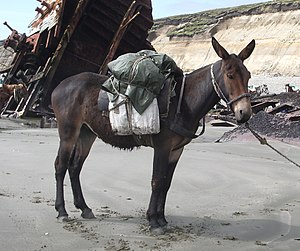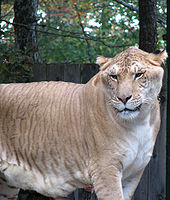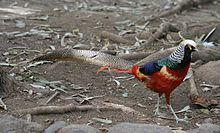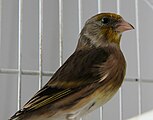Hybrid (biology)

In biology, a hybrid is the offspring resulting from combining the qualities of two organisms of different varieties, species or genera through sexual reproduction. Generally, it means that each cell has genetic material from two different organisms, whereas an individual where some cells are derived from a different organism is called a chimera.[1] Hybrids are not always intermediates between their parents (such as in blending inheritance), but can show hybrid vigor, sometimes growing larger or taller than either parent. The concept of a hybrid is interpreted differently in animal and plant breeding, where there is interest in the individual parentage. In genetics, attention is focused on the numbers of chromosomes. In taxonomy, a key question is how closely related the parent species are.
Species are
Etymology

The term hybrid is derived from Latin hybrida, used for crosses such as of a tame sow and a wild boar. The term came into popular use in English in the 19th century, though examples of its use have been found from the early 17th century.
As seen by different disciplines
Animal and plant breeding
From the point of view of animal and plant breeders, there are several kinds of hybrid formed from crosses within a species, such as between different
Population hybrids result from the crossing of plants or animals in one population with those of another population. These include interspecific hybrids or crosses between different breeds.[9] In biology, the result of crossing of two populations is called a synthetic population.[10]
In horticulture, the term stable hybrid is used to describe an annual plant that, if grown and bred in a small monoculture free of external pollen (e.g., an air-filtered greenhouse) produces offspring that are "true to type" with respect to phenotype; i.e., a true-breeding organism.[11]
Biogeography
Hybridization can occur in the hybrid zones where the geographical ranges of species, subspecies, or distinct genetic lineages overlap. For example, the butterfly Limenitis arthemis has two major subspecies in North America, L. a. arthemis (the white admiral) and L. a. astyanax (the red-spotted purple). The white admiral has a bright, white band on its wings, while the red-spotted purple has cooler blue-green shades. Hybridization occurs between a narrow area across New England, southern Ontario, and the Great Lakes, the "suture region". It is at these regions that the subspecies were formed.[12] Other hybrid zones have formed between described species of plants and animals.
Genetics
From the point of view of genetics, several different kinds of hybrid can be distinguished.[13][14] A genetic hybrid carries two different
Genetic complementation
Genetic complementation is a hybridization test widely used in genetics to determine whether two separately isolated mutants that have the same (or similar) phenotype are defective in the same gene or in different genes (see Complementation (genetics) article).[18] If a hybrid organism containing the genomes of two different mutant parental organisms displays a wild type phenotype, it is ordinarily considered that the two parental mutant organisms are defective in different genes. If the hybrid organism displays a distinctly mutant phenotype, the two mutant parental organisms are considered to be defective in the same gene. However, in some cases the hybrid organism may display a phenotype that is only weakly (or partially) wild-type, and this may reflect intragenic (interallelic) complementation.
Taxonomy
From the point of view of taxonomy, hybrids differ according to their parentage. Hybrids between different
Biology
Expression of parental traits

When two distinct types of organisms breed with each other, the resulting hybrids typically have intermediate traits (e.g., one plant parent has red flowers, the other has white, and the hybrid, pink flowers).[25] Commonly, hybrids also combine traits seen only separately in one parent or the other (e.g., a bird hybrid might combine the yellow head of one parent with the orange belly of the other).[25]
Mechanisms of reproductive isolation
Interspecific hybrids are bred by mating individuals from two species, normally from within the same genus. The offspring display traits and characteristics of both parents, but are often
A variety of mechanisms limit the success of hybridization, including the large genetic difference between most species. Barriers include morphological differences, differing times of fertility, mating behaviors and cues, and physiological rejection of sperm cells or the developing embryo. Some act before fertilization; others after it.[28][29][30][31]
In plants, some barriers to hybridization include blooming period differences, different pollinator vectors, inhibition of pollen tube growth, somatoplastic sterility, cytoplasmic-genic male sterility and structural differences of the chromosomes.[32]
Speciation
A few animal species are the result of hybridization. The
Hybridization may be important in speciation in some plant groups. However, homoploid hybrid speciation (not increasing the number of sets of chromosomes) may be rare: by 1997, only eight natural examples had been fully described. Experimental studies suggest that hybridization offers a rapid route to speciation, a prediction confirmed by the fact that early generation hybrids and ancient hybrid species have matching genomes, meaning that once hybridization has occurred, the new hybrid genome can remain stable.[42]
Many hybrid zones are known where the ranges of two species meet, and hybrids are continually produced in great numbers. These hybrid zones are useful as biological model systems for studying the mechanisms of speciation. Recently DNA analysis of a bear shot by a hunter in the Northwest Territories confirmed the existence of naturally occurring and fertile grizzly–polar bear hybrids.[43]
Hybrid vigour

Hybridization between reproductively isolated species often results in hybrid offspring with lower fitness than either parental. However, hybrids are not, as might be expected, always intermediate between their parents (as if there were blending inheritance), but are sometimes stronger or perform better than either parental lineage or variety, a phenomenon called heterosis, hybrid vigour, or heterozygote advantage. This is most common with plant hybrids.[44] A transgressive phenotype is a phenotype that displays more extreme characteristics than either of the parent lines.[45] Plant breeders use several techniques to produce hybrids, including line breeding and the formation of complex hybrids. An economically important example is hybrid maize (corn), which provides a considerable seed yield advantage over open pollinated varieties. Hybrid seed dominates the commercial maize seed market in the United States, Canada and many other major maize-producing countries.[46]
In a hybrid, any trait that falls outside the range of parental variation (and is thus not simply intermediate between its parents) is considered heterotic. Positive heterosis produces more robust hybrids, they might be stronger or bigger; while the term negative heterosis refers to weaker or smaller hybrids.
Human influence
Anthropogenic hybridization
Hybridization is greatly influenced by human impact on the environment,
Management

There is a kind of continuum with three semi-distinct categories dealing with anthropogenic hybridization: hybridization without introgression, hybridization with widespread introgression (backcrossing with one of the parent species), and
Conservationists disagree on when is the proper time to give up on a population that is becoming a hybrid swarm, or to try and save the still existing pure individuals. Once a population becomes a complete mixture, the goal becomes to conserve those hybrids to avoid their loss. Conservationists treat each case on its merits, depending on detecting hybrids within the population. It is nearly impossible to formulate a uniform hybridization policy, because hybridization can occur beneficially when it occurs "naturally", and when hybrid swarms are the only remaining evidence of prior species, they need to be conserved as well.[50]
Genetic mixing and extinction
Regionally developed
Effect on biodiversity and food security
In agriculture and
Different taxa
In animals
Mammals
Familiar examples of
The first known instance of hybrid speciation in marine mammals was discovered in 2014. The clymene dolphin (Stenella clymene) is a hybrid of two Atlantic species, the spinner and striped dolphins.[64] In 2019, scientists confirmed that a skull found 30 years earlier was a hybrid between the beluga whale and narwhal, dubbed the narluga.[65]
Birds
Cagebird breeders sometimes breed bird hybrids known as
Amphibians
Among amphibians, Japanese giant salamanders and Chinese giant salamanders have created hybrids that threaten the survival of Japanese giant salamanders because of competition for similar resources in Japan.[67]
Fish
Among fish, a group of about fifty natural hybrids between Australian blacktip shark and the larger common blacktip shark was found by Australia's eastern coast in 2012.[68]
Russian sturgeon and American paddlefish were hybridized in captivity when sperm from the paddlefish and eggs from the sturgeon were combined, unexpectedly resulting in viable offspring. This hybrid is called a sturddlefish.[69][70]
Cephalochordates
The two genera Asymmetron and Branchiostoma are able to produce viable hybrid offspring, even if none have lived into adulthood so far, despite the parents' common ancestor living tens of millions of years ago.[71][72]
Insects
Among insects, so-called
The Colias eurytheme and C. philodice butterflies have retained enough genetic compatibility to produce viable hybrid offspring.[74] Hybrid speciation may have produced the diverse Heliconius butterflies,[75] but that is disputed.[76]
The two closely related harvester ant species Pogonomyrmex barbatus and Pogonomyrmex rugosus have evolved to depend on hybridization. When a queen fertilizes her eggs with sperm from males of her own species, the offspring is always new queens. And when she fertilizes the eggs with sperm from males of the other species, the offspring is always sterile worker ants (and because ants are haplodiploid, unfertilized eggs become males). Without mating with males of the other species, the queens are unable to produce workers, and will fail to establish a colony of their own.[77]
-
A "zonkey", a zebra/donkey hybrid
-
A "jaglion", a jaguar/lion hybrid
-
Adomestic canary/goldfinch hybrid
In plants

Plant species hybridize more readily than animal species, and the resulting hybrids are fertile more often. Many plant species are the result of hybridization, combined with polyploidy, which duplicates the chromosomes. Chromosome duplication allows orderly meiosis and so viable seed can be produced.[78]
Plant hybrids are generally given names that include an "×" (not in italics), such as Platanus × acerifolia for the London plane, a natural hybrid of P. orientalis (oriental plane) and P. occidentalis (American sycamore).[79][80] The parent's names may be kept in their entirety, as seen in Prunus persica × Prunus americana, with the female parent's name given first, or if not known, the parent's names given alphabetically.[81]
Plant species that are genetically compatible may not hybridize in nature for various reasons, including geographical isolation, differences in flowering period, or differences in pollinators. Species that are brought together by humans in gardens may hybridize naturally, or hybridization can be facilitated by human efforts, such as altered flowering period or artificial pollination. Hybrids are sometimes created by humans to produce improved plants that have some of the characteristics of each of the parent species. Much work is now being done with hybrids between crops and their wild relatives to improve disease resistance or climate resilience for both agricultural and horticultural crops.[82]
Some
-
An ornamental lily hybrid known as Lilium 'Citronella'[90]
Sterility in a non-polyploid hybrid is often a result of chromosome number; if parents are of differing chromosome pair number, the offspring will have an odd number of chromosomes, which leaves them unable to produce chromosomally balanced
In humans
There is evidence of hybridization between modern humans and other species of the genus
In 1998, a complete prehistorical skeleton found in
Mythology

Folk tales and myths sometimes contain mythological hybrids; the
See also
- Bird hybrid
- Canid hybrid
- Chimera (genetics)
- Chloroplast capture (botany)
- Eukaryote hybrid genome
- Endogenous retrovirus
- Retrovirus
- Felid hybrids
- Genetic admixture
- Genetic erosion
- Grex (horticulture)
- Hybridity
- Hybridogenesis
- Hybrot
- Inbreeding
- Breeding back
- Interspecific pregnancy
- Xenotransplantation – Transplantation of cells or tissue across species
- Xenotransfusion – Transfer of blood from one animal's veins into another's
- Horizontal gene transfer
- Inferring horizontal gene transfer
- GloFish
- Agrobacterium, a bacterium well known for its ability to transfer DNA between itself and plants.
- Gene delivery
- List of plant hybrids
- List of genetic hybrids
- Macropod hybrids
- Purebred
- Selective breeding
- Genetic use restriction technology
Notes
References
- ^ Taddeo, Sarah; Robert, Jason S. (4 November 2014). "'Hybrids and Chimeras: A Consultation on the Ethical and Social Implications of Creating Human/Animal Embryos in Research' 2007, by the HFEA". The Embryo Project. Arizona State University.
- ^ "Hybrid". Online Etymology Dictionary. Archived from the original on 16 March 2016. Retrieved 28 June 2017.
- ^ "When the sire is a lion the result is termed a Liger, while the converse is a Tigon." Edward George Boulenger, World natural history, B. T. Batsford ltd., 1937, p. 40
- ^ Wricke, Gunter; Weber, Eberhard (1986). Quantitative genetics and selection in plant breeding. W. de Gruyter. p. 257.
- ISBN 9781588292025. Archivedfrom the original on 15 December 2019. Retrieved 27 May 2017.
- JSTOR 2527461.
- from the original on 10 April 2017. Retrieved 31 August 2017.
- ^ "Topcross". Merriam-Webster. Archived from the original on 21 March 2017. Retrieved 20 March 2017.
- ^ McCarthy, Eugene M. "Hybrid Populations". Macroevolution. Archived from the original on 21 March 2017. Retrieved 20 March 2017.
- PMID 26313446.
- ISBN 9780789455208.
- S2CID 42438552.
- ^ ISBN 9780387520544.
- ^ a b c d e f Allendorf, Fred (2007). Conservation and the Genetics of Populations. Blackwell. p. 534.
- ^ ISBN 9789401575874. Archivedfrom the original on 20 March 2017. Retrieved 20 March 2017.
- ^ De Vries, Hugo (1901–1903). Die mutationstheorie (in German). Vol. I and II. Leipzig: Von Veit.
- from the original on 18 January 2021. Retrieved 23 August 2020.
- PMID 4879184.
- ^ Allendorf, Fred (2007). Conservation and the Genetics of Populations. Blackwell. pp. 421–448.
- ISBN 9780393950212.
- ISBN 9780195099751.
- PMID 9105723.
- ^ Johnsgard, Paul A. (1983). "Hybridisation & Zoogeographic Patterns in Pheasants". University of Nebraska - Lincoln. p. 5. Archived from the original on 17 August 2017. Retrieved 20 March 2017.
- ISBN 9780323148788. Archivedfrom the original on 11 July 2020. Retrieved 20 March 2017.
- ^ a b McCarthy, Eugene M. (2006). Handbook of Avian Hybrids of the World. Oxford University Press. pp. 16–17.
- ISBN 9780393950212.
- PMID 3378453.
- PMID 13796002.
- S2CID 28978466.
- ISBN 9788428203692.
- ^ Futuyma, D. (1998). Evolutionary Biology (3rd ed.). Sunderland: Sinauer.
- S2CID 37518270.
- ^ PMID 25059383.
- ^ Esch, Mary (31 May 2011). "Study: Eastern wolves are hybrids with coyotes". Boston.com. Associated Press. Archived from the original on 22 March 2017. Retrieved 22 March 2017.
- doi:10.1016/j.biocon.2012.05.017. Archived (PDF) from the original on 9 October 2022.[permanent dead link]
- .
- ^ Dumbacher, J. (January 2014). "Review of Proposed Rule Regarding Status of the Wolf Under the Endangered Species Act" (PDF). FWS.gov. NCEAS. Archived from the original (PDF) on 11 June 2014.
- S2CID 86140137.
- PMID 27754477.
- ^ Daley, Jason. "Cave Paintings Help Unravel the Mystery of the 'Higgs Bison'". Smithsonian. Archived from the original on 21 October 2016. Retrieved 20 October 2016.
- ISBN 9780851996851.
- .
- ^ "Hybrid bear shot dead in Canada". BBC News. 13 May 2006. Archived from the original on 22 June 2006. Retrieved 10 June 2006.
- S2CID 22964055.
- S2CID 2651616.
- ^ Smith, C. Wayne (2004). Corn: Origin, History, Technology, and Production. Wiley. p. 332.
- ISBN 9780195183238.
- ^ Darwin, Charles (1868). Variation of Animals and Plants under Domestication. Vol. II. p. 125.
- ^ Spicer, J. W. G. (1854). "Note on hybrid gallinaceous birds". The Zoologist. 12: 4294–4296.
- ^ .
- PMID 5545198.
- ^ Vitousek, Peter; et al. (1997). "Introduced Species: A Significant Component of Human-cause Global Change". New Zealand Journal of Ecology. 21 (1): 1–16.
- PMID 11344292.
- .
- ISSN 1440-6845. RIRDC Publication No. 01/114; RIRDC Project No CPF - 3A. Archived from the original(PDF) on 2 January 2004.
- S2CID 145626108.
- ^ "Genetic Pollution: The Great Genetic Scandal" Devinder Sharma Archived 18 May 2009 at the Wayback Machine; Bulletin 28
- ^ Troyer, A. Forrest. Breeding Widely Adapted Cultivars: Examples from Maize. Encyclopedia of Plant and Crop Science, 27 February 2004.
- ^ Griesbach, Robert J. (1986). "That Reciprocal Cross — Is It a Mule or Hinny?" (PDF). Awards Quarterly. 17 (3): 149. Archived (PDF) from the original on 20 March 2017. Retrieved 19 March 2017.
- S2CID 12671275.
- PMID 24903145.
- ISBN 9780674091306.
- ^ "Part donkey, part wild ass, the kunga is the oldest known hybrid bred by humans". Science News. 14 January 2022. Retrieved 14 January 2022.
- ^ Bhanoo, Sindya (13 January 2014). "Scientists Find Rare Hybrid of Two Other Dolphin Species". The New York Times. Archived from the original on 29 May 2020. Retrieved 20 January 2014.
- ^ Kovrind, Mikkel; eight others. "Hybridization between two high Arctic cetaceans confirmed by genomic analysis". Archived from the original on 11 June 2020. Retrieved 6 June 2020.
- ^ "British Mule/Hybrid". Severn Counties Foreign & British Bird Society. Archived from the original on 5 May 2017. Retrieved 19 March 2017.
- ^ "Godzilla vs. Godzilla—How the Chinese Giant Salamander is taking a toll on its Japanese Comic Counterpart". Amphibians.org. Archived from the original on 30 June 2017. Retrieved 12 March 2017.
- ^ Voloder, Dubravka (3 January 1012). "Print Email Facebook Twitter More World-first hybrid sharks found off Australia". ABC News. Archived from the original on 5 January 2012. Retrieved 5 January 2012.
- from the original on 16 July 2020. Retrieved 16 July 2020.
- PMID 32640744.
- .
- .
- ^ Hall, H. Glenn; Zettel-Nalen, Catherine; Ellis, James D. "African Honey Bee: What You Need to Know". University of Florida IFAS Extension. Archived from the original on 23 June 2008. Retrieved 19 March 2017.
- PMID 28563983.
- PMID 17319954.
- PMID 21113790.
- ^ Inter-genomic sexual conflict drives antagonistic coevolution in harvester ants
- PMID 27895205.
- ISBN 9783874294256. Archivedfrom the original on 25 December 2018. Retrieved 19 March 2017.
- ^ "'Columbia' and 'Liberty' Planetree" (PDF). U.S. National Arboretum. 1999. Archived (PDF) from the original on 15 March 2017. Retrieved 19 March 2017.
- ISBN 9780521685535. Archivedfrom the original on 20 November 2018. Retrieved 20 November 2018.
- PMID 25326621.
- JSTOR 1221447.
- .
- ISBN 9780333920688.
- ^ "Mint Genomics Resource: Species". Lange Laboratory, Washington State University. Archived from the original on 21 March 2017. Retrieved 20 March 2017.
- ^ Hull, R. (2009). "A Short Guide to the London Plane" (PDF). Archived (PDF) from the original on 6 December 2019. Retrieved 2 February 2016.
- ^ Venables, B. (4 March 2015). "The Secret History of the London Plane Tree". Londonist. Archived from the original on 2 February 2016. Retrieved 2 February 2016.
- ^ "Legacy Bulbs Six". Pacific Bulb Society. Archived from the original on 26 December 2016. Retrieved 20 March 2017.
- ^ "Lilium Hybrids". Pacific Bulb Society. Archived from the original on 11 March 2015. Retrieved 22 March 2015.
- ^ "University of Colorado Principles of Genetics (MCDB 2150) Lecture 33: Chromosomal changes: Monosomy, Trisomy, Polyploidy, Structural Changes". University of Colorado. 21 November 2000. Archived from the original on 14 October 2012.
- ^ Burr, Benjamin; Burr, Frances (2 October 2000). "How do seedless fruits arise and how are they propagated?". Scientific American. Archived from the original on 20 March 2017. Retrieved 20 March 2017.
- S2CID 23003860.
- PMID 20448178.
- PMID 25043035.
- PMID 10377462.
- ^ Bower, Bruce (5 October 2016). "Animal hybrids may hold clues to Neandertal-human interbreeding". Sciencenews. Archived from the original on 12 September 2017. Retrieved 23 May 2017.
- PMID 26098372.
- .
- ^ "Minotauros". Theoi. Archived from the original on 22 March 2021. Retrieved 20 March 2017.
- ^ "Bestiary". Theoi. Archived from the original on 22 March 2017. Retrieved 20 March 2017.
- ISBN 9780674039766.
- ISBN 9780674069411.
- ^ Boyd, Gregory A. God at War: The Bible & Spiritual Conflict. IVP Academic. p. 177.
External links
- Artificial Hybridisation Archived 8 March 2021 at the Wayback Machine – Artificial Hybridisation in orchids
- Domestic Fowl Hybrids
- Scientists Create Butterfly Hybrid – Creation of new species through hybridization was thought to be common only in plants, and rare in animals (archived 3 December 2008)
- What is a human admixed embryo? (archived 25 February 2012)




![A sterile hybrid between Trillium cernuum and T. grandiflorum[citation needed]](http://upload.wikimedia.org/wikipedia/commons/thumb/c/c0/Trilliumhybrid2.jpg/222px-Trilliumhybrid2.jpg)
![An ornamental lily hybrid known as Lilium 'Citronella'[90]](http://upload.wikimedia.org/wikipedia/commons/thumb/2/2b/Lily_Lilium_%27Citronella%27_Flower.jpg/232px-Lily_Lilium_%27Citronella%27_Flower.jpg)